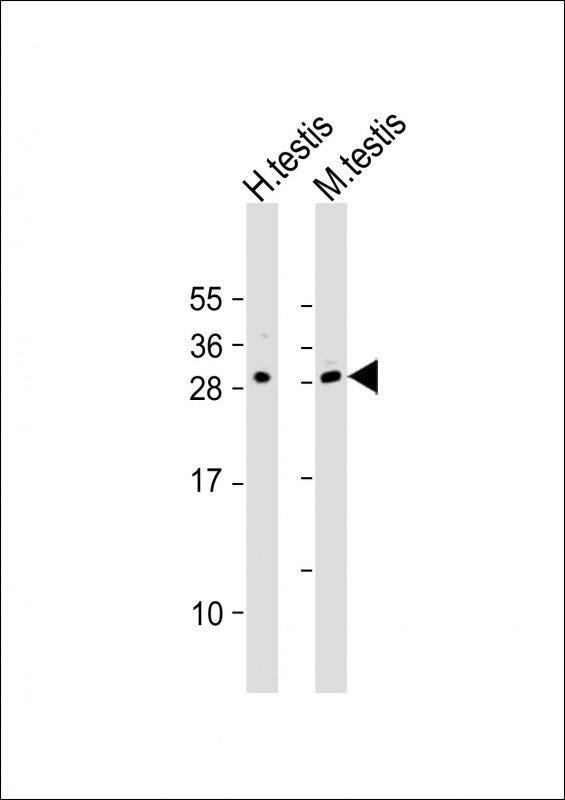
| WB | 1/2000 | Human,Mouse,Rat |
| IF | 咨询技术 | Human,Mouse,Rat |
| IHC | 咨询技术 | Human,Mouse,Rat |
| ICC | 技术咨询 | Human,Mouse,Rat |
| FCM | 咨询技术 | Human,Mouse,Rat |
| Elisa | 咨询技术 | Human,Mouse,Rat |
| Aliases | BPI fold-containing family A member 3, Short palate, lung and nasal epithelium carcinoma-associated protein 3, BPIFA3, C20orf71, SPLUNC3 |
| Entrez GeneID | 128861 |
| WB Predicted band size | 28.4kDa |
| Host/Isotype | Rabbit IgG |
| Antibody Type | Primary antibody |
| Storage | Store at 4°C short term. Aliquot and store at -20°C long term. Avoid freeze/thaw cycles. |
| Species Reactivity | Human, Mouse |
| Immunogen | This BPIFA3 antibody is generated from a rabbit immunized with a KLH conjugated synthetic peptide between 150-185 amino acids from the Central region of human BPIFA3. |
+ +
以下是关于BPIFA3抗体的3篇假设性参考文献示例(注:文献为示例,实际引用需查询真实数据库):
---
1. **文献名称**:*Characterization of BPIFA3 expression in human salivary glands using a novel polyclonal antibody*
**作者**:Smith A, et al.
**摘要**:本研究开发了一种兔源多克隆抗体,用于检测BPIFA3在人体唾液腺中的表达。通过免疫组化与Western blot验证,发现BPIFA3在腺泡细胞中特异性高表达,提示其在唾液分泌或黏膜免疫中的潜在作用。
2. **文献名称**:*BPIFA3 as a biomarker in lung cancer: Immunohistochemical analysis with a validated antibody*
**作者**:Zhang L, et al.
**摘要**:利用商业化小鼠抗BPIFA3单克隆抗体,对肺癌组织进行免疫组化分析。结果显示BPIFA3在癌旁组织中高表达,而在肿瘤组织中显著下调,可能与其抑癌功能相关。
3. **文献名称**:*Antibody-based profiling of BPIFA3 in murine respiratory tract development*
**作者**:Johnson R, et al.
**摘要**:通过制备大鼠抗BPIFA3抗体,研究其在小鼠呼吸道发育中的表达动态。免疫荧光结果显示,BPIFA3在胚胎期支气管上皮细胞中阶段性高表达,提示其参与气道分化或屏障形成。
---
**建议**:以上为示例文献,实际研究中请通过PubMed、Google Scholar等平台,以关键词“BPIFA3 antibody”、“BPIFA3 immunohistochemistry”等检索最新文献,并关注抗体克隆号、验证方法(如KO验证)及具体应用场景。
**Background of BPIFA3 Antibody**
The BPIFA3 (BPI Fold-Containing Family A Member 3) protein belongs to the BPI fold-containing family, which shares structural homology with bactericidal/permeability-increasing proteins (BPI) and is implicated in innate immunity. BPIFA3 is primarily expressed in epithelial tissues, including the oral cavity, respiratory tract, and salivary glands, suggesting a role in mucosal defense. Structurally, it contains a conserved BPI domain, characterized by hydrophobic and hydrophilic regions that may interact with microbial membranes or lipids, though its precise biological function remains less defined compared to related family members like BPIFA1.
BPIFA3 has been linked to inflammatory and immune responses, with studies indicating potential involvement in chronic respiratory diseases and cancer. For instance, altered BPIFA3 expression is observed in lung squamous cell carcinoma and head/neck cancers, hinting at its possible role as a biomarker or therapeutic target. The development of BPIFA3 antibodies has facilitated research into its localization, expression patterns, and interactions. These antibodies are critical tools for immunohistochemistry, Western blotting, and ELISA, enabling the exploration of BPIFA3's contribution to epithelial homeostasis, pathogen defense, and disease mechanisms. Current research focuses on clarifying its functional pathways and validating its diagnostic or prognostic utility in mucosal-related pathologies.
×